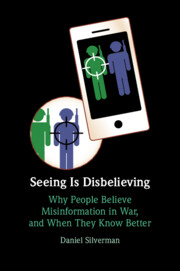74 results
The Impact of Urban Evacuation in Japan during World War II
-
- Journal:
- Asia-Pacific Journal / Volume 19 / Issue 19 / October 2021
- Published online by Cambridge University Press:
- 14 March 2025, e1
-
- Article
-
- You have access
- Open access
- Export citation
1 - Introduction
-
- Book:
- Seeing Is Disbelieving
- Published online:
- 31 August 2024
- Print publication:
- 21 November 2024, pp 1-17
-
- Chapter
- Export citation
Returning the War to Russia: Drones and Discrimination in the Defense of Ukraine
-
- Journal:
- Ethics & International Affairs / Volume 38 / Issue 1 / Spring 2024
- Published online by Cambridge University Press:
- 01 October 2024, pp. 54-63
-
- Article
-
- You have access
- Open access
- HTML
- Export citation

Seeing Is Disbelieving
- Why People Believe Misinformation in War, and When They Know Better
-
- Published online:
- 31 August 2024
- Print publication:
- 21 November 2024
Introduction
-
- Book:
- International Humanitarian Law
- Published online:
- 25 October 2024
- Print publication:
- 09 May 2024, pp 1-3
-
- Chapter
- Export citation
“Sticking together while standing one's own ground”: The meanings of solidarity in humanitarian action
-
- Journal:
- International Review of the Red Cross / Volume 106 / Issue 925 / April 2024
- Published online by Cambridge University Press:
- 20 March 2024, pp. 269-300
- Print publication:
- April 2024
-
- Article
-
- You have access
- Open access
- HTML
- Export citation
“Who Could Be Strong When Hungry?”: Food Supply and Nutrition of the Civilian Population in Maribor at the End of and after World War I
-
- Journal:
- Austrian History Yearbook / Volume 55 / May 2024
- Published online by Cambridge University Press:
- 08 March 2024, pp. 298-311
- Print publication:
- May 2024
-
- Article
-
- You have access
- HTML
- Export citation
10 - Civilians
-
- Book:
- Frontline Crisis Response
- Published online:
- 28 September 2023
- Print publication:
- 12 October 2023, pp 154-170
-
- Chapter
- Export citation
Legal technologies: Conceptualizing the legacy of the 1923 Hague Rules of Aerial Warfare
-
- Journal:
- Leiden Journal of International Law / Volume 37 / Issue 1 / March 2024
- Published online by Cambridge University Press:
- 25 September 2023, pp. 88-110
-
- Article
-
- You have access
- Open access
- HTML
- Export citation
4 - Principle of Distinction: Combatants and Civilians
-
- Book:
- International Humanitarian Law
- Published online:
- 24 August 2023
- Print publication:
- 07 September 2023, pp 102-122
-
- Chapter
- Export citation

International Humanitarian Law
- Cases, Materials and Commentary
-
- Published online:
- 24 August 2023
- Print publication:
- 07 September 2023
-
- Textbook
- Export citation
Will the centre hold? Countering the erosion of the principle of distinction on the digital battlefield
-
- Journal:
- International Review of the Red Cross / Volume 105 / Issue 923 / August 2023
- Published online by Cambridge University Press:
- 10 May 2023, pp. 965-991
- Print publication:
- August 2023
-
- Article
- Export citation
V - Contesting the Victimhood Frame
-
- Book:
- Framing a Revolution
- Published online:
- 02 March 2023
- Print publication:
- 09 March 2023, pp 126-157
-
- Chapter
- Export citation
Chapter 12 - War and Civilians
- from Part II - Foundational Concepts
-
-
- Book:
- War and Literary Studies
- Published online:
- 15 January 2023
- Print publication:
- 05 January 2023, pp 201-215
-
- Chapter
- Export citation
7 - Atrocities against Civilians
-
- Book:
- Storm and Sack
- Published online:
- 29 September 2022
- Print publication:
- 06 October 2022, pp 227-268
-
- Chapter
- Export citation
1 - Sieges in the Long Eighteenth Century
-
- Book:
- Storm and Sack
- Published online:
- 29 September 2022
- Print publication:
- 06 October 2022, pp 16-54
-
- Chapter
-
- You have access
- HTML
- Export citation
Introduction
-
- Book:
- International Law and Policy on the Protection of Civilians
- Published online:
- 11 August 2022
- Print publication:
- 25 August 2022, pp 1-16
-
- Chapter
- Export citation
17 - The African Union and the Protection of Civilians
- from Part III - State and Institutional Policies on the Protection of Civilians
-
- Book:
- International Law and Policy on the Protection of Civilians
- Published online:
- 11 August 2022
- Print publication:
- 25 August 2022, pp 201-208
-
- Chapter
- Export citation
18 - The European Union and the Protection of Civilians
- from Part III - State and Institutional Policies on the Protection of Civilians
-
- Book:
- International Law and Policy on the Protection of Civilians
- Published online:
- 11 August 2022
- Print publication:
- 25 August 2022, pp 209-218
-
- Chapter
- Export citation
20 - Switzerland and the Protection of Civilians
- from Part III - State and Institutional Policies on the Protection of Civilians
-
- Book:
- International Law and Policy on the Protection of Civilians
- Published online:
- 11 August 2022
- Print publication:
- 25 August 2022, pp 225-228
-
- Chapter
- Export citation


